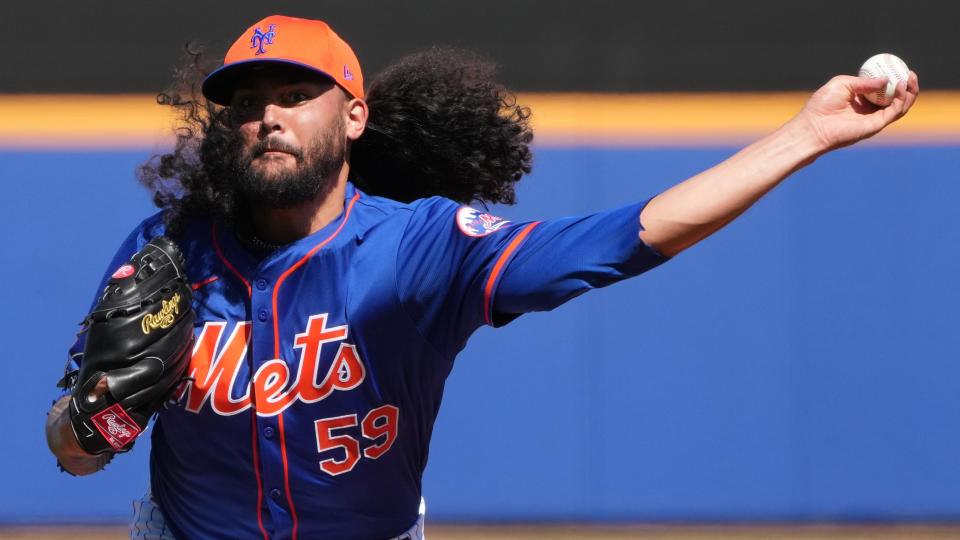Gloomy narrative surrounding Mets' potentially solid 2024 rotation is a bit wild
With Mets pitchers and catchers at spring training in Port St. Lucie, Fla., the two aces who were supposed to help carry last year's team to the promised land are far away -- literally and figuratively.
Max Scherzer is with the Texas Rangers, out until at least June after having surgery for a herniated disk during the offseason.
Justin Verlander is with the Houston Astros, behind schedule a few weeks in his preparation for the season because of a bothersome shoulder.
That Scherzer and Verlander are both delayed doesn't matter when it comes to the 2024 Mets.
However, it is notable because of the uproar it would be causing if Scherzer and Verlander were still Mets (instead of Top 100 prospects Luisangel Acuña, Drew Gilbert, and Ryan Clifford).
Of course, they're gone -- before their deals were up. And the Mets, looking to reset and add impact prospects when they traded the two aces last summer, ate a ton of money still owed to Scherzer and Verlander in order to achieve that goal.
Because the Mets went in a different direction, their rotation entering this season does not have nearly the upside it did last season. There's no debating that, regardless of the fact that Scherzer (because of performance) and Verlander (because of injury) were among the reasons New York ended up having such a brutal 2023.
With Scherzer and Verlander gone, and the Mets still looking to contend in 2024, they made a frenzied run at Japanese ace Yoshinobu Yamamoto, who chose the Los Angeles Dodgers despite the Mets offering $325 million (and the Yankees offering $300 million).
Once Yamamoto was off the board, the Mets did not pivot to Jordan Montgomery (a solid No. 2 or No. 3 who is looking to be paid like an ace), or Blake Snell (who alternates mediocre years with Cy Young years). Other teams haven't pivoted to them, either, since both are unsigned.
So the Mets have Rookie of the Year runner-up Kodai Senga, Jose Quintana, and the three rotation additions new president of baseball operations David Stearns made this offseason: Luis Severino, Sean Manaea, and Adrian Houser.

To be clear, the Mets' rotation this season -- at least on paper -- will not scare anyone. It likely won't be what carries the team. But there's a strong chance it will be solid.
One of the reasons so many people are worried seems to be the fact that the Mets don't have a true ace. To that, I'll say three things.
1. Senga is really damn good.
2. The Mets had two "true aces" last year. How did that work out?
3. You don't need a "true ace" to make the playoffs and/or win a World Series. Does it make it easier? Sure. Should the Mets be looking to sign one next offseason? Absolutely. But having one is not a necessity.
Now, back to the Mets' expected starting five...
With the exception of Senga, who is very good and whose ability can't be torn apart by people looking to be negative for the sake of it, there have been dings directed at the other four Mets starters.
Some common refrains:
Quintana is too old!
Severino was awful last season!
Manaea and Houser are bad!
Luckily, we have numbers that can adequately help us describe what those four pitchers actually are.

Quintana, despite being 35 years old (is that old now?), had a 3.57 ERA last season. He has a career ERA of 3.74, and has tossed 160 or more innings eight times in his career -- as recently as 2022.
Severino was awful last season, but it seems like an outlier. His stuff is still legit, and he was tipping pitches -- something he's been working on correcting. Before 2023, the 29-year-old had a 3.39 career ERA over six seasons. Injuries are a concern for Severino, but if he takes the ball regularly in 2024, odds are he'll resemble the pitcher he was before 2023 -- and that's a very good one.
Manaea's career ERA+ in eight big league seasons is 100, which makes him a league average pitcher -- literally. If he's average in 2024, while serving as the No. 4 starter, that will be good enough. But there's room for more, as evidenced by his increase in velocity and how he finished the 2023 season.
Houser's career ERA+ in seven major league seasons is 106. That's better than league average. And he was solid last season for the Milwaukee Brewers, with a 4.12 ERA (3.99 FIP) in 23 games (21 starts).
Again, this starting rotation will not wow you. But it doesn't have to. It just needs to get the job done.
It should also be pointed out that the Mets' starting rotation depth is miles better than it was last season, when -- beyond the back end starters of Carlos Carrasco, David Peterson, and Tylor Megill -- there wasn't much.
This season, the Mets will again have Jose Butto and Joey Lucchesi to turn to if needed -- as well as Megill and (eventually) Peterson. But they also have prospects Christian Scott -- who was ranked on three Top 100 lists this offseason -- and Mike Vasil.
Both Scott and Vasil should debut at some point this season.
The upshot to all of this? The Mets' rotation is getting way too much flak, and a look at the numbers of the pitchers in it will tell you that perhaps Stearns -- an executive the team is thrilled to have -- knows what he's doing.

